Production of Triploid Seedless Sweet Orange [Citrus sinensis (L.) Osbeck] cv. Mosambi: A Success Story
Abstract
1. Introduction
2. Materials and Methods
2.1. Plant Materials
2.2. Primary Callus Induction, Proliferation, and Embryogenesis
2.3. Lab-to-Land Transfer
2.4. Ploidy Analysis
2.5. Cytology
2.6. Stomatal Morphology
2.7. Analysis of Fruit Quality Parameters
2.8. Statistical Analysis
3. Results
3.1. Age of Responsive Endosperm
3.2. Callus Induction and Proliferation
3.3. Effect of Media on Morphogenesis of Embryogenic Callus
3.4. Effect of Phytohormones on Shoot and Root Differentiation
3.5. Morphological Characterization
3.6. Triploid Induction Ratio in Sweet Orange
3.7. Characterization of Triploid Plants by Flow Cytometry
3.8. Triploid Characterization by Cytology
3.9. Stomatal Analysis
3.10. Fruit Quality Parameters of Field-Transferred Sweet Orange Triploid Plants
4. Discussion
5. Conclusions
Author Contributions
Funding
Data Availability Statement
Conflicts of Interest
References
- Available online: https://agriwelfare.gov.in/en/StatHortEst (accessed on 12 March 2024).
- Fatta, D.B.; Matrango, S.G.; Geraci, G. Micro and macro sporogenesis of two triploid hybrids of citrus. Proc. Int. Soc. Citric. 1992, 1, 122–124. [Google Scholar]
- Grosser, J.W.; Ollitrault, P.; Olivares-Fuster, O. Somatic hybridization in Citrus: An effective tool to facilitate cultivar improvement. In Vitro Cellular and Development Biology. Plant 2000, 36, 434–449. [Google Scholar]
- Soost, R.K.; Cameron, J.W. Citrus. In Advances in Fruit Breeding; Janick, J., Moore, J.N., Eds.; Purdue University Press: West Lafayette, IN, USA, 1975; pp. 507–540. [Google Scholar]
- Germana, M.A.; Chiancone, B.; Lain, O.; Testolin, R. Anther culture in Citrus clementina: A way to regenerate tri-haploids. Aust. J. Agric. Res. 2005, 56, 839–845. [Google Scholar] [CrossRef]
- Esen, A.; Soost, R.K. Tetraploid progenies from 2x × 4x crosses of citrus and their origin. J. Am. Soc. Hortic. Sci. 1971, 97, 410–414. [Google Scholar] [CrossRef]
- Ollitrault, P.; Dambier, D.; Luro, F.; Froelicher, Y. Ploidy manipulation for breeding seedless triploid citrus. Plant Breed. Rev. 2008, 30, 323–354. [Google Scholar]
- Soost, R.K.; Cameron, J.W. ‘Melogold’, a triploid pummelo-grapefruit hybrid. HortScience 1985, 20, 1134–1135. [Google Scholar] [CrossRef]
- Thomas, T.D.; Rakhi, C. Endosperm culture: A novel method for triploid plant production. Plant Cell Tissue Organ Cult. 2008, 93, 1–14. [Google Scholar] [CrossRef]
- Gmitter, F.G., Jr.; Hu, X. The possible role of Yunan, China, in the origin of contemporary Citrus species (Rutaceae). Econ. Bot. 1990, 44, 267–277. [Google Scholar] [CrossRef]
- Lampe, L.; Mills, C.O. Growth and development of isolated endosperm and embryo of maize. Bull. Torrey Bot. Club 1936, 63, 365–382. [Google Scholar]
- Popielarska-Konieczna, M.; Kleszcz, I. Preliminary studies on plants regenerated from endosperm-derived callus of kiwifruit (Actinidia deliciosa var. deliciosa). Mod. Phytomorphology 2015, 7, 55–57. [Google Scholar]
- Patil, M.B.; Panchal, V.M. Comparative studies on ‘Nucellar’, ‘Sathgudi’ and ‘Local’ sweet orange (Mosambi) (Citrus sinensis Osbeck.) under Marathwada conditions. J. Hortic. Sci. 2016, 11, 44–46. [Google Scholar] [CrossRef]
- Murashige, T.; Tucker, D.P.H. Growth factor requirements of citrus tissue culture. Proc. First Int. Citrus Symp. 1969, 3, 1155–1161. [Google Scholar]
- Murashige, T.; Skoog, F. A revised medium for rapid growth and bio assays with tobacco tissue cultures. Physiol. Plant. 1962, 15, 473–497. [Google Scholar] [CrossRef]
- Kesara, A.J. Preparation of chromosome from plant leaf meristems for karyotype analysis and in situ hybridization. Methods Cell Sci. 2003, 25, 91–95. [Google Scholar]
- Krug, C.A. Chromosome number in the subfamily Aurantioideae with special reference to the genus Citrus. Bot. Gazzette 1943, 104, 602–611. [Google Scholar] [CrossRef]
- Vardi, A.; Levin, I.; Carmi, N. Induction of Seedlessness in Citrus: From Classical Techniques to emerging Biotechnological Approaches. J. Am. Soc. Hortic. Sci. 2008, 133, 117–126. [Google Scholar] [CrossRef]
- Bhojwani, S.S.; Razdan, M.K. Plant Tissue Culture: Theory and Practice. A Revised Edition; Elsevier: Amsterdam, The Netherlands; Lausanne, Switzerland; New York, NY, USA; Oxford, UK; Shannon, Ireland; Tokyo, Japan, 1996; pp. 1–767. [Google Scholar]
- Mooney, P.; Watson, M.; Harty, A. Developing New Seedless Citrus Triploid Cultivars. Hort. Res. Publ. 2007, 1–13. [Google Scholar]
- Vijayakumari, N.; Pooja, K. In vitro regeneration from hybrid endosperm tissue of Nagpur mandarin: A new research inroad towards seedless Citrus triploid cultivars. Indian Hortic. 2013, 18–19. [Google Scholar]
- Asakura, I.; Hoshino, Y. Endosperm-derived triploid plant regeneration in diploid ctinidiakolomikta, a cold-hardy kiwifruit relative. Sci. Hortic. 2017, 219, 53–59. [Google Scholar] [CrossRef]
- Wang, X.; Cheng, Z.M.; Zhi, S.X.F. Breeding Triploid Plants: A Review. Czech. J. Gen. Plant Breed. 2016, 52, 41–54. [Google Scholar] [CrossRef]
- Wang, D.Y. In vitro culture of Citrus embryos. Chin. J. Bot. 1975, 17, 149–152. [Google Scholar]
- Góralski, G.; Popielarska, M.; Slesak, H.; Siwinska, D.; Batycka, M. Organogenesis in endosperm of Actinidia deliciosa cv. Hayward cultured in vitro. Acta Biol. Cracov. Bot. 2005, 47, 121–128. [Google Scholar]
- Thomas, T.D.; Bhatnagar, A.K.; Bhojwani, S.S. Production of triploid plants of mulberry (Morus alba L.) by endosperm culture. Plant Cell Rep. 2000, 19, 395–399. [Google Scholar] [CrossRef] [PubMed]
- Silva, N.T.D.; Silva, L.A.S.; Rels, A.C.; Machado, M.; Matos, E.M.D.; Ciccini, L.F.; Otoni, W.C.; Carvalho, I.F.D.; Rocha, D.I.; Silva, M.L.D. Endosperm culture: A facile and efficient biotechnological tool to generate passion fruit (Passiflora cincinnata Mast.) triploid plants. Plant Cell Tissue Organ Cult. 2020, 142, 613–624. [Google Scholar] [CrossRef]
- Raza, H.; Mumtaz, K.; Asifi, A.K. Review seedless in citrus. Int. J. Agric. Biol. 2003, 5, 388–391. [Google Scholar]
- Sajid, A.; Ahmad, S.K.; Syed, A.R.; Rana, N.U.R. Innovative breeding methods to develop seedless citrus cultivars. Int. J. Biosci. 2013, 3, 191–201. [Google Scholar]
- Rakhi, C.; Maharaj, K.R.; Sant, S.B. An efficient protocol for the production of triploid plants from endosperm callus of Neem, Azadirachta indica A. Juss. J. Plant Physiol. 2003, 160, 557–564. [Google Scholar]
- Mooney, P.; Richardson, A.C.; Marsh, K.B. Applications of biotechnology to cultivar improvement in New Zealand. Acta Hortic. 2000, 535, 207–212. [Google Scholar] [CrossRef]
- Beck, S.L.; Dunlop, R.; Fossey, A. Stomatal length and frequency as a measure of ploidy level in black wattle, Acacia mearnsii (de Wild). Bot. J. Linn. Soc. 2003, 141, 177–181. [Google Scholar] [CrossRef]
- Alzea, P.; Juarez, J.; Cuenca, J.; Ollitrault, P.; Navarro, L. Recovery of citrus triploid hybrids by embryo rescue and flow Cytometry from 2x × 2x sexual hybridisation and its application to extensive breeding programs. Plant Cell Rep. 2010, 29, 1023–1034. [Google Scholar] [CrossRef]
- Diego, P.; Amr, M.; Benedetta, C.; Maria, A.G.; Patan, S.S.V.K. Ploidy levels in Citrus clementine affects leaf morphology, stomatal density and water content. Theor. Exp. Plant Physiol. 2013, 25, 283–290. [Google Scholar]
- Zhou, J.; Hirata, Y.; Nou, I.S.; Shiotani, H.; Ito, T. Interactions between different genotypic tissues in citrus graft chimeras. Euphytica 2002, 126, 355–364. [Google Scholar] [CrossRef]
- Ye, Y.M.; Tong, J.; Shi, X.P.; Yuan, W.; Li, G.R. Morphological and cytological studies of diploid and colchicine-induced tetraploid lines of crape myrtle (Lagerstroemia indica L.). Sci. Hortic. 2010, 124, 95–101. [Google Scholar] [CrossRef]
- Spiegel, R.P.; Varid, A. Shani, Drah and Winsla three new selections from our breeding program. Proc. Int. Soc. Citric. 1992, 1, 72–73. [Google Scholar]

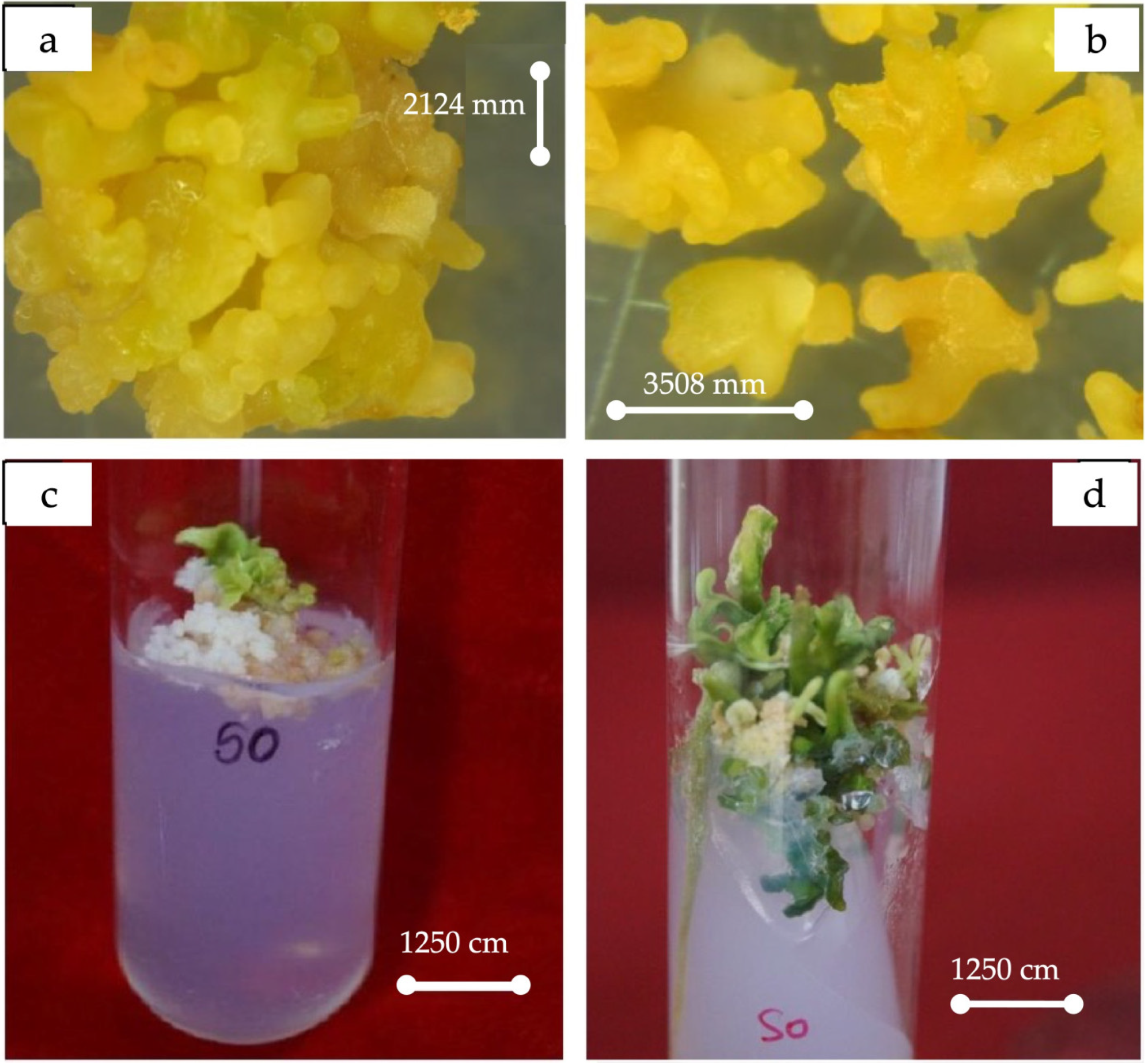


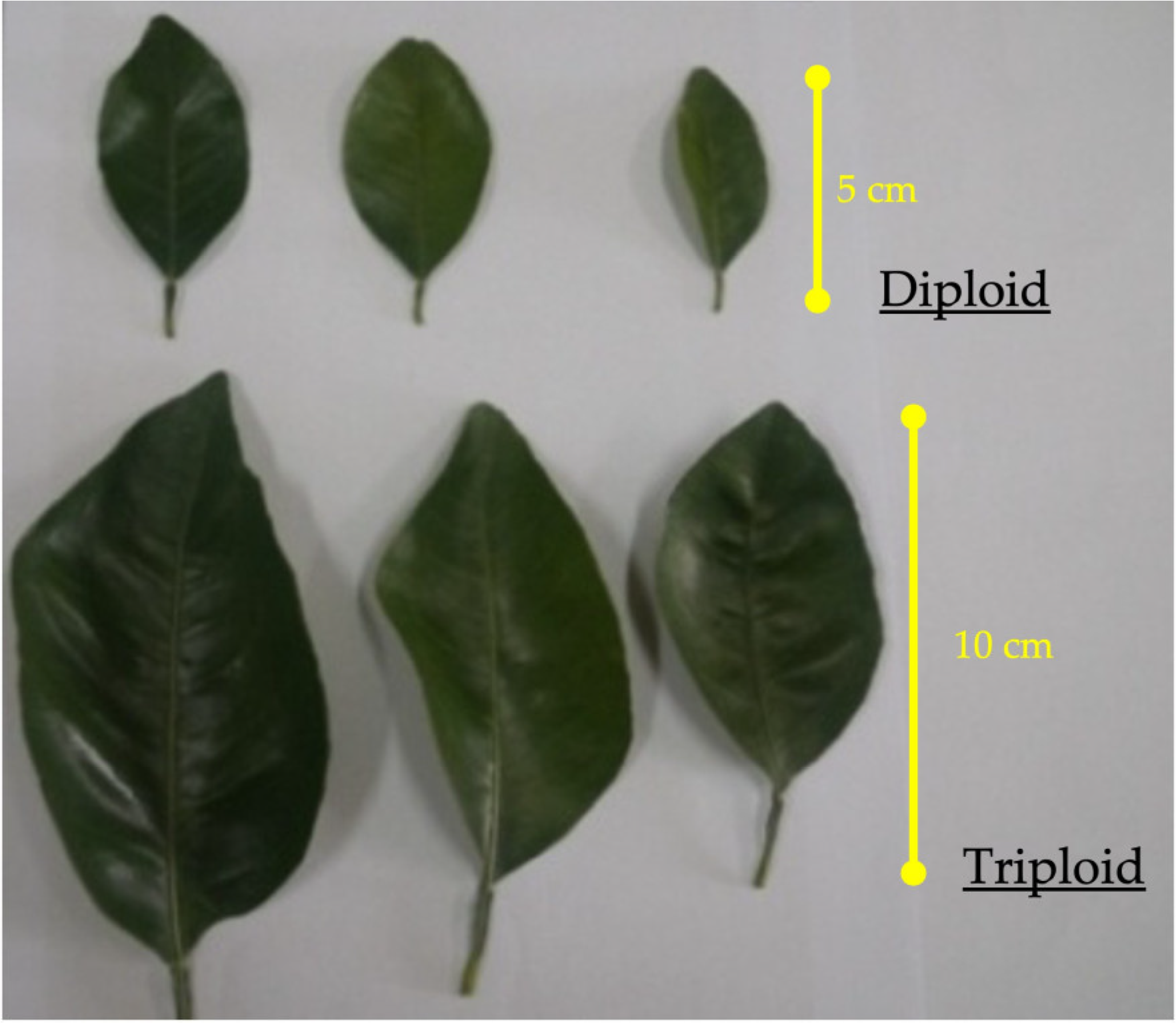

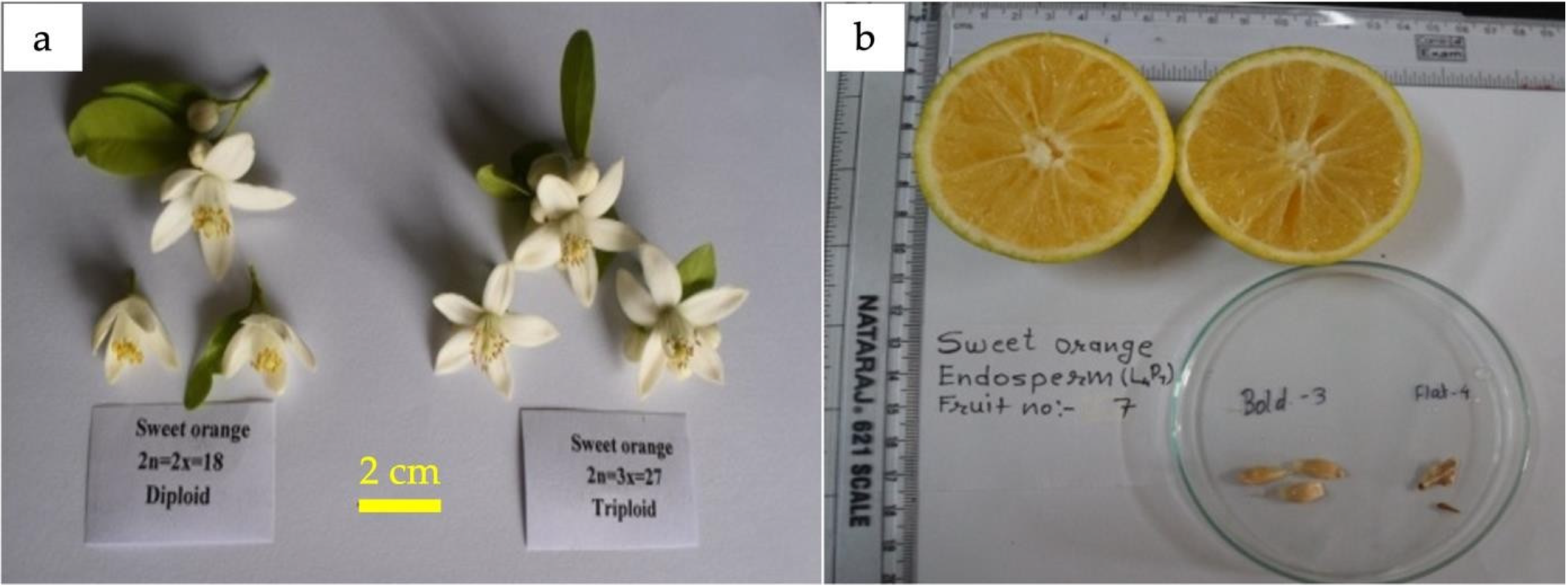
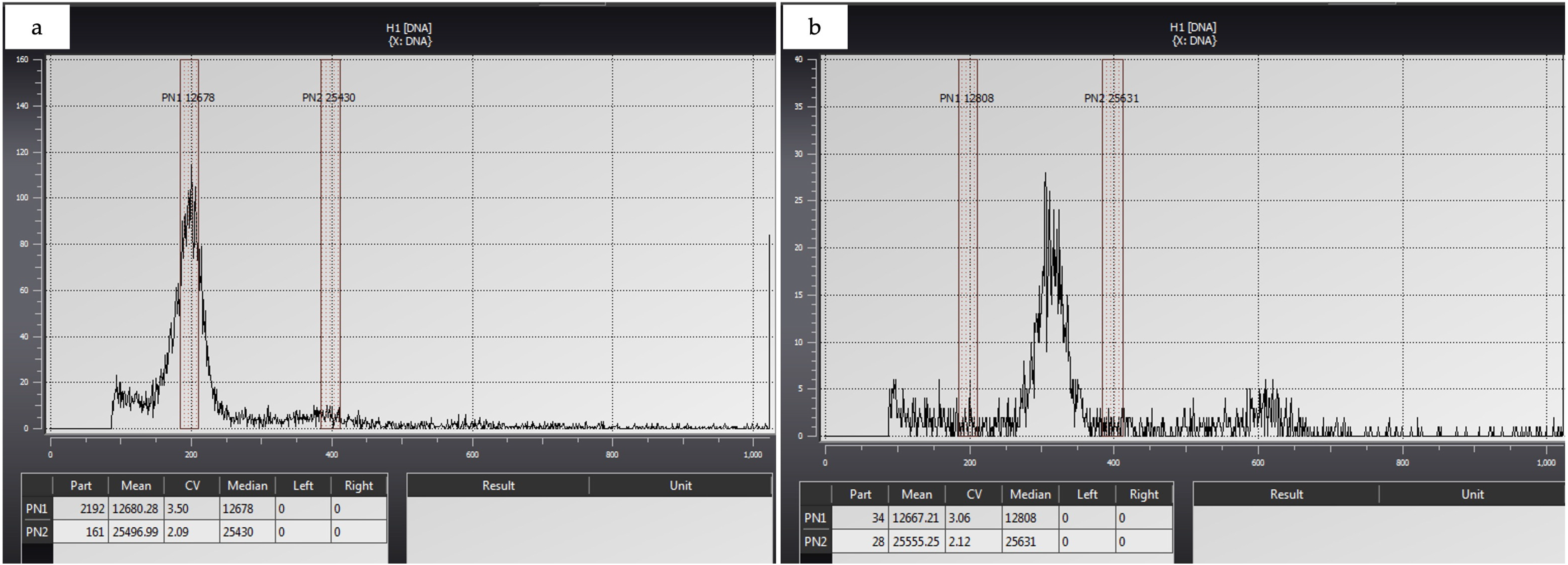
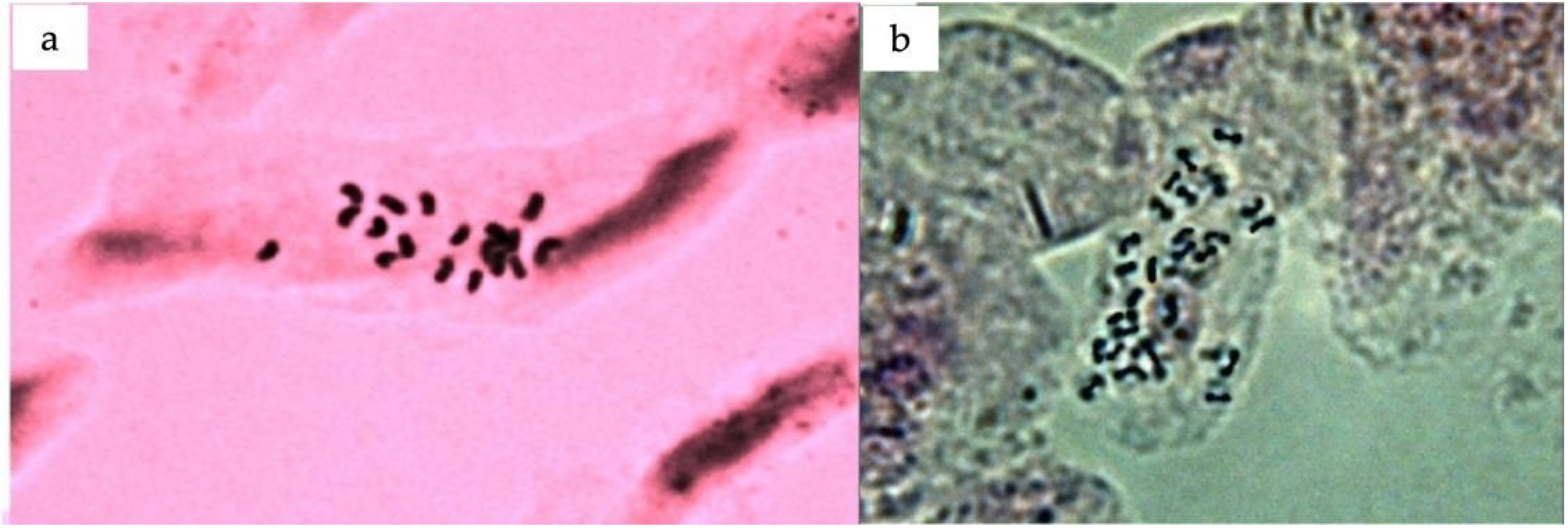
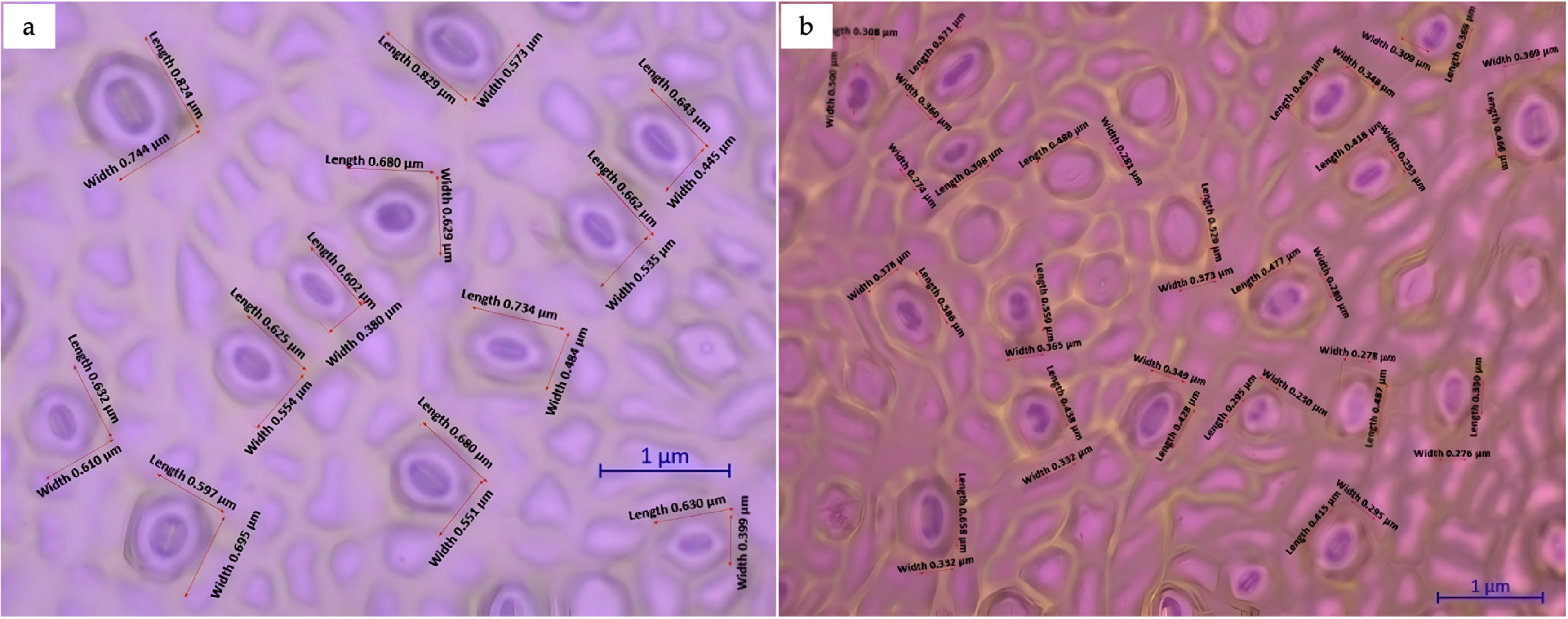
| Culture Medium | Survival (%) | Response (%) | Days Taken | Callus Initiation | |
|---|---|---|---|---|---|
| MT + ME (500 mg/L) | 52.69 (46.69) | 22.34 (28.28) | 32.08 | 17.83 (25.02) | |
| MT + CH (500 mg/L) + BA (5 mg/L) + 2,4-D (2 mg/L) | 14.77 (22.54) | 59.23 (50.31) | 34.91 | 15.08 (22.84) | |
| MT + CH (500 mg/L) + 2,4-D (2 mg/L) | 61.9 (51.91) | 53.36 (46.92) | 29.13 | 31.34 (34.03) | |
| MS + ME (500 mg/L) | 31.83 (31.31) | 31.01 (33.87) | 25.08 | 35.72 (36.69) | |
| MT + ME + CH (500 mg/L) + 2,4-D (2 mg/L) | 70.40 (57.04) | 78.16 (61.13) | 22.96 | 47.57 (43.57) | |
| CD | 0.01% | 0.907 ** | 0.779 ** | 0.710 ** | 0.710 ** |
| 0.05% | 0.656 * | 0.563 * | 0.556 * | 0.556 * | |
| Culture Medium | Embryogenesis (Days) | Embryogenic Callus (%) | Differentiation of Embryoids | ||||
|---|---|---|---|---|---|---|---|
| Globular | Heart | Torpedo | Cotyledonary | ||||
| MS + CH (500 mg/L) | 25.63 | 19.85 (26.45) | 26.7 (27.07) | 19.67 (26.31) | 18.07 (25.16) | 10.56 (18.95) | |
| MT + CH (500 mg/L) + GA3 (1 mg/L) + BA (0.25 mg/L) | 21.76 | 52.05 (46.17) | 23.6 (29.08) | 24.68 (29.78) | 31.05 (33.86) | 17.48 (24.55) | |
| 2MT + CH (500 mg/L) + GA3 (1 mg/L) + BA (0.25 mg/L) | 23.97 | 11.95 (20.21) | 37.7 (37.09) | 22.67 (28.46) | 24.56 (29.69) | 14.52 (22.63) | |
| 2MT + CH (500 mg/L) + GA3 (1 mg/L) + Ad.S (2 mg/L + BA (0.25 mg/L) | 19.97 | 73.69 (59.13) | 27.5 (31.67) | 24.65 (31.67) | 23.56 (29.03) | 16.91 (27.72) | |
| 2MT + ME + Ad.S (2 mg/L) + GA3 (2 mg/L) + BA (2 mg/L) | 17.92 | 77.74 (61.84) | 22.6 (28.43) | 26.78 (31.64) | 26.63 (31.06) | 22.57 (28.35) | |
| CD | 0.01% | 0.403 ** | 0.587 ** | 1.335 ** | 0.272 ** | 0.426 ** | 0.704 ** |
| 0.05% | 0.291 * | 0.424 * | 0.965 * | 0.197 * | 0.308 * | 0.509 * | |
| Culture Medium | Response (%) | Shoot Initiation (Days) | Root Initiation (Days) | Shoot (No.) | Root (No.) | Length of Shoot (cm) | Length of Root (cm) | |
|---|---|---|---|---|---|---|---|---|
| MT + Ad.S (10 mg/L) + GA3 (1 mg/L) | 76.57 (61.00) | 10.69 | 11.70 | 2.6 | 2.52 | 2.45 | 2.0 | |
| MT + ME + GA3 (1 mg/L) | 88.63 (70.27) | 12.57 | 26.6 | 3.03 | 3.6 | 3.3 | 3.0 | |
| MT + IBA (2 mg/L) | 69.76 (55.88) | 8.75 | 24.56 | 3.05 | 3.8 | 2.6 | 2.5 | |
| MT + Ad.S (10 mg/L) + GA3 (1 mg/L) + IBA (0.5 mg/L) | 84.61 (66.85) | 18.68 | 27.57 | 0.85 | 1.57 | 1.85 | 1.16 | |
| MT + ME + Ad.S (10 mg/L) + GA3 (2 mg/L) | 92.54 (74.08) | 7.61 | 10.58 | 3.15 | 4.17 | 3.3 | 4.3 | |
| MT + Ad.S (10 mg/L) + BA (2 mg/L) + GA3 (2 mg/L) | 54.39 (47.35) | 14.49 | 22.66 | 1.6 | 2.2 | 1.05 | 2.1 | |
| CD | 0.01% | 0.388 ** | 0.306 ** | 0.621 ** | 0.352 ** | 0.498 ** | 0.532 ** | 0.379 ** |
| 0.283 * | 0.224 * | 0.453 * | 0.257 * | 0.363 * | 0.388 * | 0.276 * | ||
| Leaf Area | ||
|---|---|---|
| Diploid | 8.23 | |
| Triploid | 28.61 | |
| CD | 0.01 | 2.657 ** |
| 0.05 | 1.966 * |
| Stages in Endosperm Culture | Endosperm Culture | Primary Callus Induction | Embryogenesis and Morphogenesis | Complete Plantlet Regeneration | Transfer by Mini-Grafting |
|---|---|---|---|---|---|
| Selected best culture medium | MT + ME + CH (500 mg/L) + 2,4-D (2 mg/L) | MT +ME + CH (500 mg/L) + 2,4-D (2 mg/L) | 2MT + ME (500 mg/L) + Ad.s (2 mg/L) + GA3+ (2 mg/L) + BA (2 mg/L) | MT + ME + Ad.S (2 mg/L) + GA3 (2 mg/L) | |
| Total fruitlets | 25 | ||||
| Immature seeds | 120 | ||||
| Tender endosperm from immature seed (no.) | 90 | ||||
| Response of endosperm for callus induction (%) | 78.16 | ||||
| Callus induction (%) | 47.57 | ||||
| Induction of somatic embryogenesis | 77.74 | ||||
| Morphogenesis—cotyledonary | 22.57 | ||||
| Shape response to plantlet regeneration (%) | 92.54 | ||||
| Plants generated (no.) | 125 | ||||
| Putative triploid plants (no.) | 70 | ||||
| Lab-to-land transfer by mini-grafting | 40 | ||||
| Confirmed triploid plants | 7 |
| Triploid Stoma Length | Diploid Stoma Length | Triploid Stoma Width | Diploid Stoma Width | |
|---|---|---|---|---|
| Stoma count | 12 | 19 | 12 | 19 |
| Average length and width of stomata (µm) | 0.683 | 0.463 | 0.550 | 0.315 |
| SD | 0.077 | 0.091 | 0.111 | 0.045 |
| Variance | 0.006 | 0.008 | 0.012 | 0.002 |
| T-statistic | 6.959 | 8.252 | ||
| T-table (0.01) | 2.756 ** | 2.756 ** | ||
| T-table (0.05) | 2.045 * | 2.045 * | ||
| Plant No. | Fruit Weight (g) | Fruit Diameter (mm) | Peel Thickness (mm) | No. of Segments | Seed Number Bold/Flat | Juice (%) | TSS (°Brix) | Acidity (%) | Vitamin C (mg/100 g) | Limonene (ppm) |
|---|---|---|---|---|---|---|---|---|---|---|
| 1 | 149.25 | 67.07 | 4.4 | 11.0 | 5.9/4.7 | 41.6 | 8.5 | 0.87 | 34.4 | 8.89 |
| 2 | 196.2 | 61.8 | 4.6 | 11.6 | 5/1 | 36.8 | 7.8 | 1.08 | 39 | 11.34 |
| 3 | 118.9 | 62.75 | 5.2 | 10.95 | 5.6/4.2 | 39.9 | 10.62 | 0.63 | 38.73 | 7.77 |
| 4 | 156.4 | 65.11 | 4.66 | 9.32 | 5.5/7.21 | 35.65 | 8.15 | 1.1 | 42.66 | 9.56 |
| 5 | 114 | 53.1 | 3.5 | 10.88 | 3.2/1.8 | 31.8 | 8.16 | 1.1 | 41.2 | 8.64 |
| 6 | 123.1 | 61.8 | 4.6 | 11.5 | 2/1 | 26.0 | 10.1 | 0.6 | 36.6 | - |
| 7 | 192 | 75.5 | 5 | 11.6 | 4.6/1.3 | 34.3 | 10.08 | 0.8 | 36 | - |
| Control (Diploid) | 103.1 | 56.4 | 5.1 | 11.8 | 10.9/2.7 | 51.6 | 9.42 | 0.93 | 31.8 | 10.33 |
Disclaimer/Publisher’s Note: The statements, opinions and data contained in all publications are solely those of the individual author(s) and contributor(s) and not of MDPI and/or the editor(s). MDPI and/or the editor(s) disclaim responsibility for any injury to people or property resulting from any ideas, methods, instructions or products referred to in the content. |
© 2024 by the authors. Licensee MDPI, Basel, Switzerland. This article is an open access article distributed under the terms and conditions of the Creative Commons Attribution (CC BY) license (https://creativecommons.org/licenses/by/4.0/).
Share and Cite
Narukulla, V.; Lahane, Y.; Uge, P.; Pandey, S.; Fiske, K.; Kawale, K.; Jagannadham, P.T.K.; Ziogas, V. Production of Triploid Seedless Sweet Orange [Citrus sinensis (L.) Osbeck] cv. Mosambi: A Success Story. Agronomy 2024, 14, 829. https://doi.org/10.3390/agronomy14040829
Narukulla V, Lahane Y, Uge P, Pandey S, Fiske K, Kawale K, Jagannadham PTK, Ziogas V. Production of Triploid Seedless Sweet Orange [Citrus sinensis (L.) Osbeck] cv. Mosambi: A Success Story. Agronomy. 2024; 14(4):829. https://doi.org/10.3390/agronomy14040829
Chicago/Turabian StyleNarukulla, Vijayakumari, Yogesh Lahane, Priya Uge, Shashi Pandey, Krutika Fiske, Kartiki Kawale, Prasanth Tej Kumar Jagannadham, and Vasileios Ziogas. 2024. "Production of Triploid Seedless Sweet Orange [Citrus sinensis (L.) Osbeck] cv. Mosambi: A Success Story" Agronomy 14, no. 4: 829. https://doi.org/10.3390/agronomy14040829
APA StyleNarukulla, V., Lahane, Y., Uge, P., Pandey, S., Fiske, K., Kawale, K., Jagannadham, P. T. K., & Ziogas, V. (2024). Production of Triploid Seedless Sweet Orange [Citrus sinensis (L.) Osbeck] cv. Mosambi: A Success Story. Agronomy, 14(4), 829. https://doi.org/10.3390/agronomy14040829







